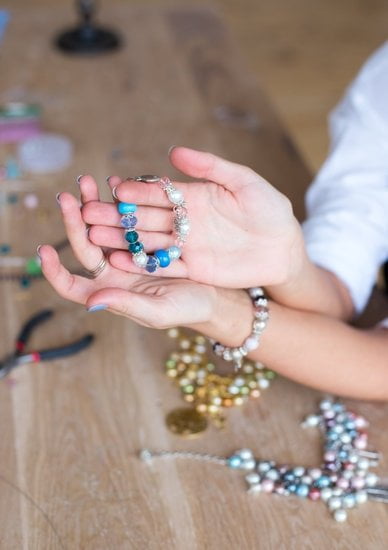Diamonds have long been cherished as symbols of love and luxury, but for those unfamiliar with the intricacies of the jewelry industry, understanding the meaning behind a diamond stamp can be a perplexing task. In this article, we will delve into the significance of these tiny imprints found on jewelry and unravel the mystery behind their existence.
By exploring the importance of certification, decoding the numbers and letters on diamond stamps, and shedding light on the diamond grading systems used by certification bodies, we aim to empower consumers with the knowledge needed to identify and appreciate a diamond stamp.
When it comes to purchasing diamond jewelry, its value extends far beyond its aesthetic beauty. The presence of a diamond stamp holds great significance as it serves as proof of authenticity and quality. However, deciphering these stamps can often be confusing for many individuals who are not familiar with their meanings. That is why it is crucial to understand why certification is important in order to unravel this mystery behind diamond stamps.
In this article, we will address common questions such as: What do the numbers and letters signify on a diamond stamp? Who determines these stamps? What are some industry-standard markings? Additionally, we will delve into topics such as verifying the authenticity of a certified diamond and discuss both advantages and disadvantages for buyers when investing in diamond-stamped jewelry.
By equipping readers with comprehensive knowledge about diamond stamps, we hope to not only demystify their significance but also enable buyers to make more informed decisions when it comes to purchasing valuable pieces. So join us on this journey as we unravel the secrets behind these glittering imprints – let’s begin exploring what really lies beneath that small but significant marking etched onto your precious gemstone.
Importance of certification
The importance of certification cannot be underestimated when it comes to unraveling the mystery behind diamond stamps on jewelry. When purchasing a piece of diamond-stamped jewelry, it is crucial to understand the significance of the stamp and what it represents. Certification provides valuable information about the quality and authenticity of a diamond, giving consumers confidence in their purchase.
One way to decode the diamond stamp is by understanding what the numbers and letters signify. These markings often indicate specific characteristics of the diamond, such as its carat weight, color grade, clarity grade, and cut grade. This information helps buyers make informed decisions based on their preferences and budget. For example, a stamp with “0.75 ct” indicates that the diamond has a carat weight of 0.75.
To ensure consistency and credibility in the diamond industry, various certification bodies have established grading systems. These organizations set standards for evaluating diamonds based on criteria such as cut, color, clarity, and carat weight. The most well-known certification bodies include the Gemological Institute of America (GIA), American Gem Society (AGS), International Gemological Institute (IGI), and European Gemological Laboratory (EGL). Each organization has its own grading scales and methodologies for assessing diamonds.
Gemological laboratories play a crucial role in determining the diamond stamp on jewelry. These labs are responsible for examining diamonds using specialized instruments and techniques to determine their characteristics and produce an accurate certification report. The certifications issued by reputable gemological laboratories provide assurance to buyers that they are receiving genuine diamonds with accurate grading information.
In summary, certification plays a vital role in unraveling the mystery behind diamond stamps on jewelry. Understanding what these stamps signify empowers consumers to make confident purchasing decisions based on the quality and authenticity of diamonds. By relying on reputable certification bodies and gemological laboratories, buyers can ensure they are investing in genuine diamonds with accurate grading information.
Decoding the diamond stamp
One of the most important aspects of understanding a diamond stamp on jewelry is decoding the numbers and letters that are often present. These codes provide valuable information about the characteristics and quality of the diamond, allowing buyers to make informed decisions. The numbers and letters on a diamond stamp generally refer to the diamond’s grading and certification.
The first thing to look for when decoding a diamond stamp is the carat weight. Carat weight refers to the size of the diamond, with one carat equaling 200 milligrams. This number is typically represented as a decimal, such as 0.50 or 1.00.
Next, the clarity grade is indicated by letters ranging from “FL” (flawless) to “I3” (included). The clarity grade reveals any imperfections or blemishes present in the diamond.
Additionally, the color grade of a diamond can be deciphered using letters ranging from “D” (colorless) to “Z” (light yellow or brown). The color grade evaluates how much color is present in the diamond.
Finally, cut grade indicates how well a diamond has been cut and proportioned. This grade can range from “Excellent” to “Poor,” with an excellent cut resulting in maximum brilliance and fire.
Together, these numbers and letters give consumers insight into a diamond’s quality and value. However, it’s important to note that not all diamonds have stamped certifications. Some may come with separate certificates or documentation instead.
Diamond grading systems
Diamond grading systems play a crucial role in determining the quality and value of a diamond. They provide buyers with a standardized method of evaluating diamonds and ensure transparency in the industry. This section will delve into the different certification bodies and their standards, shedding light on how they contribute to the diamond stamp found on jewelry.
One of the most widely recognized certification bodies is the Gemological Institute of America (GIA). Founded in 1931, it has set the benchmark for diamond grading worldwide. The GIA certification is highly regarded and trusted by consumers and professionals alike. Their grading system focuses on the “Four Cs” – carat weight, color, clarity, and cut – which are essential factors in assessing a diamond’s quality.
Another prominent certification body is the American Gem Society (AGS), which also uses the Four Cs as its grading criteria. However, AGS puts more emphasis on cut quality compared to other factors. The AGS Diamond Grading Report provides detailed information about a diamond’s proportions, symmetry, polish, and overall craftsmanship.
In addition to these two renowned organizations, there are several other well-established certification bodies such as the International Gemological Institute (IGI) and the European Gemological Laboratory (EGL). While their standards may slightly differ from each other and from GIA or AGS, these certification bodies still provide valuable insights into a diamond’s characteristics.
Understanding these various certification bodies and their standards helps consumers make informed decisions when purchasing diamond-stamped jewelry. It allows them to compare diamonds based on consistent criteria and ensures they are getting what they pay for. Ultimately, it reinforces trust within the industry by providing a universally acknowledged language for understanding diamond quality through the diamond stamp on jewelry.
Who determines the diamond stamp? Insights into the role of gemological laboratories
Gemological laboratories play a crucial role in determining the diamond stamp on jewelry. These labs are responsible for objectively examining and grading diamonds based on their quality and characteristics. Gemological laboratories utilize state-of-the-art equipment and highly trained gemologists to evaluate diamonds according to strict industry standards.
One of the most well-known gemological laboratories is the Gemological Institute of America (GIA). Established in 1931, the GIA has become synonymous with diamond certification. The GIA issues grading reports that provide detailed information about a diamond’s 4Cs – carat weight, color, clarity, and cut. These reports also include additional information, such as fluorescence and polish.
Another prominent gemological laboratory is the International Gemological Institute (IGI). Similar to the GIA, the IGI evaluates diamonds based on their 4Cs. However, the IGI is known for its slightly more lenient grading standards compared to the GIA. This means that if a diamond receives a certain grade from the IGI, it may be graded slightly lower by the GIA.
Other notable gemological laboratories include the American Gem Society (AGS) and the European Gemological Laboratory (EGL). Each of these labs has its own grading systems and standards. It’s important for consumers to be aware of these variations when interpreting a diamond stamp on jewelry.
The role of gemological laboratories extends beyond just certifying diamonds. They also contribute to ongoing research and development within the industry. By conducting studies on diamonds and sharing their findings with jewelers, manufacturers, and consumers, these laboratories help improve understanding and appreciation for diamonds as precious gemstones.
Overall, gemological laboratories serve as unbiased third-party entities that determine the diamond stamp on jewelry. Their expertise ensures that consumers can trust in the authenticity and quality of certified diamonds. By relying on reputable labs like GIA or IGI, buyers can make informed decisions when purchasing diamond-stamped jewelry.
Common diamond stamps and their meanings
When it comes to purchasing diamond jewelry, understanding the industry-standard markings is crucial. Each marking on a diamond stamp signifies specific information about the stone, such as its cut, clarity, color, and carat weight. This section will explore some common diamond stamps and their meanings, providing consumers with valuable insights into identifying and interpreting these marks.
One of the most well-known diamond stamps is the “4Cs” system developed by the Gemological Institute of America (GIA). This system assesses diamonds based on four factors: cut, clarity, color, and carat weight. The GIA assigns a grade to each category to denote the quality of the stone. For example, a “D” grade indicates that the diamond has exceptional colorless qualities.
Another popular diamond stamp is the certification from the American Gem Society (AGS). The AGS follows a similar grading system to GIA but provides additional information on light performance. Their Light Performance Grading specifies how well a diamond reflects and refracts light, contributing to its overall brilliance.
The International Gemological Institute (IGI) is another notable certification body that uses its own grading system for diamonds. They also provide detailed reports on a diamond’s characteristics but don’t assign letter grades like GIA or AGS. Instead, IGI provides descriptive terms such as “Excellent,” “Very Good,” “Good,” etc., in different categories.
Understanding these common diamond stamps can be invaluable for consumers seeking to make an informed purchase. By familiarizing themselves with these markings, buyers can better assess a diamond’s quality and value before making a decision.
| Diamond Stamp | Meaning |
|---|---|
| GIA Certification | An internationally recognized grading system developed by the Gemological Institute of America, providing information on a diamond’s cut, clarity, color, and carat weight. Uses a letter grading scale. |
| AGS Certification | A certification from the American Gem Society that follows a similar grading system to GIA but includes additional information on light performance. Provides detailed reports on a diamond’s characteristics and assigns letter grades. |
| IGI Certification | A certification from the International Gemological Institute that uses its own grading system for diamonds. Provides descriptive terms like “Excellent,” “Very Good,” “Good,” etc., in different categories without assigning letter grades. |
Verifying the diamond stamp
Verifying the authenticity of a certified diamond is crucial for consumers who want to ensure they are getting a genuine and high-quality piece of jewelry. In this section, we will explore some important steps and considerations to take when verifying the diamond stamp on jewelry.
Seek documentation
When purchasing diamond-stamped jewelry, always ask for the accompanying documentation, such as a certificate or grading report. This document provides detailed information about the diamond’s characteristics, including its cut, color, clarity, and carat weight. It is essential to verify that the document matches the diamond in question and has been issued by a reputable gemological laboratory.
Research the gemological laboratory
Not all gemological laboratories are created equal, so it is important to research and understand the reputation of the laboratory that issued the certification. Look for laboratories with established credibility and recognition within the industry, such as the Gemological Institute of America (GIA) or American Gem Society (AGS). Certifications from these well-regarded institutions carry more weight and are generally more reliable.
Authenticate through laser inscription
Many diamonds today come with laser inscriptions that can be viewed under magnification. These inscriptions usually include a unique identification number or grading report number that corresponds to the certification document. By comparing the inscription to the certification, buyers can verify that they have received the same diamond as described in the paperwork.
Consult with experts
If you are unsure about verifying a diamond stamp on your own, consider consulting with an independent expert or reputable jeweler who can guide you through this process. They have experience in identifying genuine diamonds and can help confirm whether a certified diamond is authentic or not.
Ultimately, verifying the authenticity of a certified diamond takes time and effort but is worthwhile for consumers seeking peace of mind regarding their purchase. By following these steps and taking precautions, buyers can be confident that they are investing in a genuine diamond piece of jewelry.
Investing in diamond-stamped jewelry
Investing in diamond-stamped jewelry can be a significant decision for buyers, as it involves a substantial financial commitment. Understanding the advantages and disadvantages of purchasing certified diamond jewelry can help buyers make informed choices and ensure they are making a worthwhile investment.
Advantages of buying diamond-stamped jewelry
- Authenticity: One of the primary advantages of buying diamond-stamped jewelry is the assurance of authenticity. The diamond stamp signifies that the piece has undergone professional grading and certification. This gives buyers confidence that they are purchasing a genuine diamond with accurate specifications regarding its cut, clarity, color, and carat weight.
- Value retention: Another advantage of investing in diamond-stamped jewelry is its potential for value retention or appreciation. Diamonds have historically held their value over time, making them durable and solid investments. Properly certified diamonds are more likely to maintain their worth compared to non-certified stones.
- Trustworthy purchase: When buying certified diamond-stamped jewelry, buyers can have peace of mind knowing that expert gemologists have evaluated and graded the stone. This adds credibility to the purchase, as buyers can trust the accuracy of the information provided on the certification report.
Disadvantages of buying diamond-stamped jewelry
- Higher cost: Certified diamond-stamped jewelry often comes at a higher price due to various factors such as the cost involved in obtaining certification from reputable gemological laboratories and additional expenses incurred during the grading process. Buyers should be prepared to pay a premium for this assurance of quality.
- Limited options: While certified diamonds offer quality assurance, it’s important to note that not all diamonds in the market undergo certification or receive stamps. This means that buyers may have limited options when it comes to choosing certified diamond-stamped pieces based on their preferred specifications, designs, or budget constraints.
- Lack of flexibility: Once a diamond is stamped and certified, any alteration or modification to the jewelry can impact its certification and value. This lack of flexibility may be considered a disadvantage for buyers who prefer customization or personalization options in their jewelry.
By understanding the advantages and disadvantages of investing in diamond-stamped jewelry, buyers can make well-informed decisions based on their personal preferences, budget, and long-term goals. Additionally, it is crucial for buyers to conduct thorough research, seek trusted jewelers who provide genuine certifications, and examine all relevant documentation before making a purchase.
With this knowledge and diligence, buyers can feel confident in their ability to select high-quality diamond-stamped jewelry that will meet their expectations and potentially serve as a valuable investment over time.
Beyond the diamond stamp
When purchasing diamond jewelry, it is important to consider more than just the diamond stamp. While the stamp denotes the certification and authenticity of the diamond, there are other factors that should be taken into account to ensure a high-quality purchase.
One factor to consider is the quality of the diamond itself. The diamond’s 4Cs – cut, color, clarity, and carat – play a crucial role in determining its overall value and appearance. The cut refers to how well the facets have been shaped and arranged, influencing its sparkle and brilliance.
The color grade evaluates the presence of any yellow or brown tints in white diamonds, with higher grades indicating a purer white color. Clarity refers to the presence of any internal or external flaws called inclusions and blemishes respectively, with higher clarity grades signifying fewer imperfections. Finally, carat weight determines the size of the diamond.
Another important consideration is the metal used in the jewelry setting. Common options include gold (including white, yellow, and rose), platinum, and silver. Each type of metal has its own unique properties such as durability, hypoallergenic nature (important for those with sensitive skin), and price point.
Additionally, one must think about the design and style of the jewelry piece itself. Factors such as personal preference, occasion for wearing it, and lifestyle should be taken into account when selecting a specific piece. Whether it is an engagement ring or a pendant necklace, finding jewelry that reflects one’s individual taste is essential.
Finally, considering the reputation and reliability of the jeweler or retailer is crucial when purchasing diamond jewelry. Researching their credentials before making a purchase can ensure that you are dealing with a reputable seller who adheres to ethical practices.
Conclusion
In conclusion, understanding the significance of a diamond stamp on jewelry is crucial for consumers who want to make informed purchasing decisions. This article has delved into the importance of certification and deciphering the meaning behind the numbers and letters in a diamond stamp. It has also provided insights into the role of gemological laboratories in determining these stamps.
By knowing the common diamond stamps and their meanings, consumers can navigate the jewelry market with confidence. They can verify the authenticity of a certified diamond and take advantage of investment opportunities that come with purchasing diamond-stamped jewelry. However, it is important to recognize that there are also disadvantages to investing in such pieces.
While the diamond stamp is a valuable indication of quality and authenticity, it should not be the sole factor when purchasing diamond jewelry. Other factors such as cut, color, clarity, and carat weight should also be considered. By considering these factors in addition to understanding diamond stamps, consumers can make well-informed choices that suit their style preferences and budget.
Ultimately, this article aims to empower consumers with knowledge so they can identify and appreciate a diamond stamp on jewelry. With this understanding, individuals can confidently navigate the marketplace, evaluate their options based on industry-standard markings, and ensure they are making an informed purchase that aligns with their needs and desires.
Frequently Asked Questions
What is the symbol of real diamond?
The symbol of a real diamond is often represented by the letter “D” or a similar variation. This symbol is used to indicate that the diamond is genuine and not an imitation or synthetic stone.
Jewelers may also use other marks, such as a small laser inscription on the girdle of the diamond, to identify its authenticity and unique characteristics. The symbol serves as an assurance of quality and value for consumers looking to purchase a genuine diamond.
How are diamonds marked?
Diamonds are marked using a standardized system known as the 4Cs: cut, color, clarity, and carat weight. These markings provide important information about the quality and characteristics of each diamond.
For example, the cut grade assesses how well a diamond has been fashioned from its rough form into a finished gemstone; color grades range from D (colorless) to Z (light yellow or brownish); clarity grades evaluate any blemishes or inclusions within the stone; while carat weight measures the size or mass of the diamond.
What does 925 with diamond symbol mean?
When you see the marking “925” alongside a diamond symbol, it indicates that the metal used in the jewelry item is sterling silver. Sterling silver consists of 92.5% pure silver and 7.5% other alloy metals, typically copper. This ratio is commonly used in silver jewelry-making due to its desired durability while retaining the luster and appeal of silver.
The accompanying diamond symbol suggests that there are diamonds incorporated into the piece. So, jewelry items marked “925 with diamond symbol” are indicating they are made from sterling silver with diamonds as additional embellishments or features within the design.

Welcome to my jewelry blog! My name is Sarah and I am the owner of this blog.
I love making jewelry and sharing my creations with others.
So whether you’re someone who loves wearing jewelry yourself or simply enjoys learning about it, be sure to check out my blog for insightful posts on everything related to this exciting topic!





